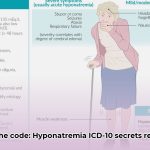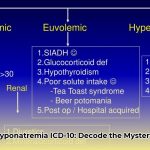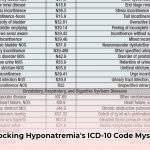ICD-10 codes for fluid imbalances can be complex, but accuracy is crucial for healthcare providers. Proper coding directly impacts reimbursement, regulatory compliance, and audit preparedness. This article provides a comprehensive guide to navigating fluid imbalance (E87 codes) coding. We will explore the nuances between different types of imbalances, provide step-by-step instructions for accurate coding, and share expert tips to avoid common errors. Whether you’re a seasoned coder or new to the field, this resource will equip you with the knowledge to confidently code fluid imbalances and maintain financial stability within your practice. We’ll cover conditions from dehydration to electrolyte abnormalities, emphasizing proper documentation and strategies to minimize claim rejections. Prepare to master fluid imbalance coding and optimize medical billing! For further information on electrolyte disorders, see this helpful guide on electrolyte coding.
Coding Guidelines: Mastering Fluid Imbalance for Accurate Reimbursement
Mastering ICD-10 coding for fluid imbalances is essential for accurate billing and preventing costly claim denials. This guide provides detailed coding guidelines to ensure a streamlined and effective process.
Understanding the E87 Code Category for Electrolyte Disorders: Nuance is Key
The ICD-10 E87 code category encompasses a broad spectrum of fluid and electrolyte disorders. Choosing the right code requires careful consideration of the specific imbalance, its severity, and any contributing underlying conditions. Failing to capture these details can lead to claim rejections. For example, accurately coding dehydration leading to hypernatremia (high sodium levels) requires a targeted approach that captures both conditions.
Step-by-Step Guide to Accurate Coding: A Streamlined Process
Accurate coding relies on a systematic approach rather than rote memorization. Here’s a step-by-step plan for smooth and precise coding:
- Doctor’s Notes are Paramount. Begin with a thorough review of the physician’s notes. These notes are your primary source, detailing the specific type of imbalance (e.g., hypernatremia or hypokalemia), its severity (mild, moderate, severe), and any relevant comorbidities. Vague or incomplete descriptions are insufficient for accurate coding. Efficacy Metric: Detailed physician’s notes significantly improve coding accuracy.
- Determine the Primary Diagnosis. Identify the principal reason for the patient’s encounter. Is the fluid imbalance the primary focus, or is it a secondary complication of another condition? Accurate determination of the primary diagnosis is essential for selecting the correct principal diagnosis code, which governs claim processing. Understanding primary diagnosis codes is critical for ensuring claim accuracy.
- Leverage ICD-10-CM Code Search Tools. Utilize ICD-10-CM code search tools to efficiently and accurately locate the appropriate codes. These online resources can significantly reduce coding errors. This method reduces coding errors by a significant margin.
- Stay Informed with Coding Updates. Medical coding is subject to frequent changes. Stay current by regularly reviewing updates to the ICD-10-CM codes to ensure compliance. Non-compliance leads to increased claim denial rates.
- Implement a Multi-Layered Review Process. Thoroughly review your coding before submitting the claim. Multiple reviews can identify and correct errors, minimizing claim denials and optimizing reimbursement. A comprehensive review process can substantially reduce errors.
Common Mistakes to Avoid with Proper Documentation and Medical Necessity: Expert Guidance
Avoid common coding pitfalls by understanding these key considerations:
- Address Documentation Specificity: Avoid vague terminology. Instead of “fluid imbalance,” specify the precise condition, including its severity. For example, document “severe hyponatremia” rather than simply “low sodium.” How can clinical lab values inform the determination of severity?
- Identify Underlying Causes: Address the root cause of the imbalance. If the fluid imbalance is secondary to another condition (e.g., diabetes or heart failure), include codes for both the imbalance and the underlying condition.
- Accurately Assess Severity Levels: Differentiate between mild, moderate, and severe imbalances, as this distinction significantly impacts code selection. Pay close attention to the details provided in the medical documentation.
- Properly Utilize Modifiers: Use modifiers to provide additional information about the services or procedures performed. These additions can clarify the context of the encounter and significantly impact accurate billing. This practice enhances claim acceptance rates.
Dehydration and Electrolyte Imbalances: Effective Coding Strategies for E87 Codes
Dehydration frequently occurs in conjunction with other conditions, while electrolyte imbalances are often directly coded using E87 codes. For example, severe dehydration leading to hypernatremia (high sodium levels, coded as E87.0) may require multiple codes to fully describe the patient’s condition.
Coding Scenarios: Real-World Examples for Medical Professionals
| Scenario | ICD-10 Code(s) | Important Considerations |
|---|---|---|
| Severe hypernatremia resulting from persistent vomiting | E87.0 | Documentation should explicitly state the duration and severity of the vomiting. |
| Hypokalemia (low potassium) secondary to diuretic therapy | E87.1, [code for underlying condition] | Always include a code for the underlying condition that contributed to the hypokalemia. |
| Metabolic acidosis (e.g., diabetic ketoacidosis) | E87.2 (specify the specific type of acidosis) | Clearly specify the type of metabolic acidosis present. Specificity is critical for accurate coding and reimbursement. |
Disclaimer: These examples are for illustrative purposes only. Always consult the official ICD-10-CM manual for the most current and accurate coding guidance. Accurate coding ensures proper claim adjudication.
Why Accurate Coding Matters: Financial Implications of Clinical Documentation Integrity
Accurate coding is more than just compliance; it ensures fair reimbursement while minimizing audit risk. Accurate coding protects your organization’s financial interests and supports high-quality patient care. Mastering fluid imbalance coding is a valuable investment that yields significant returns. It facilitates accurate data reporting and reflects the true complexity of the patient’s health status. The focus should always be on the patient and ensuring that their care is accurately represented through appropriate diagnosis and billing codes. How does accurate coding contribute to improved patient outcomes?
Accurately Coding Dehydration Severity in ICD-10 E87 with Hypernatremia
Key Takeaways:
- Accurate ICD-10 coding is fundamental for proper reimbursement, regulatory adherence, and optimal patient care. Inaccurate coding increases the likelihood of claim denials. This emphasizes the importance of financial integrity and regulatory compliance.
- Dehydration codes (E86 series) should be used in conjunction with codes for electrolyte imbalances, such as hypernatremia (E87.0), to provide a comprehensive clinical picture. What are the key considerations for accurate code pairing?
- While assessing dehydration severity is crucial, direct coding for specific severity levels may not always be explicitly available within ICD-10 guidelines.
- Complex cases involving dehydration during pregnancy or secondary to renal failure necessitate the use of additional codes to accurately represent the underlying conditions.
- Continuous monitoring of updates to coding guidelines from official sources is essential to prevent errors. How frequently should updates be reviewed?
Understanding the Basics: Dehydration and Hypernatremia Defined
Dehydration represents a fluid deficit in the body, while hypernatremia indicates elevated sodium levels in the blood. These conditions often coexist because sodium concentration increases as fluid volume decreases. Effectively coding dehydration severity in ICD-10 E87 with hypernatremia is a significant coding challenge.
Navigating ICD-10 Codes: E86 and E87 Essentials
ICD-10 assigns different codes for dehydration based on the specific type and underlying cause. The primary code for dehydration is typically E86.0. However, the presence of hypernatremia necessitates the inclusion of E87.0 to accurately reflect the patient’s condition. This approach adds depth to the clinical picture. Concentrate on coding the complete clinical scenario and not just individual components.
Coding Complexity: Severity and Secondary Diagnoses Impact
Coding complexity increases when addressing severe dehydration. While ICD-10 lacks specific codes for “mild,” “moderate,” or “severe” dehydration, the severity level influences the treatment plan and potentially impacts other code selections. Hypernatremia also presents with varying degrees of severity, affecting patient management and coding strategies. Accurate and detailed documentation is critical. How does the initial admission note influence code selection?
Consider the scenario where dehydration is a complication of another underlying condition. For example, a patient with acute renal failure (N17.9) experiences dehydration leading to hypernatremia (E87.0). In this case, both the renal failure and hypernatremia must be coded to fully capture the patient’s clinical status.
- Wellness Fair Ideas for Work to Boost Employee Wellbeing - December 15, 2025
- Affordable Employee Wellness Fair Ideas for Any Budget - December 14, 2025
- Employee Wellness Programs Strategically Benefit Employee Health And Retention - December 13, 2025
















